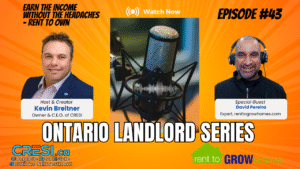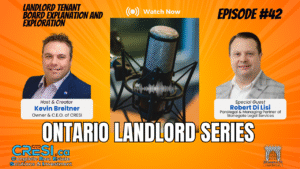Tired of Tenant Calls? Try Passive Real Estate Investing in Ontario
Are you tired of late-night calls about broken water heaters? Fed up with tenant complaints and surprise repairs? Many Ontario landlords are discovering a better way to invest in real estate.
It’s called passive real estate investing Ontario style, and it’s changing how people make money from property.
What is Passive Real Estate Investing?
Most landlords know the drill. A tenant calls at 10 PM because the furnace broke. You rush to fix it. Then next month, it’s a leaky roof. The month after that, your tenant moves out and you need to find someone new.
That’s active investing. You’re always working.
Passive real estate investing Ontario investors are doing things differently. They still own property. They still make money from tenants. But they don’t get the emergency calls. They don’t fix things. They don’t even visit the property.
The Rent-to-Own Strategy Explained
Here’s how it works in simple terms:
You buy a house for $500,000. You put down $100,000 as your investment. Then you find a tenant buyer who wants to own a home but can’t get a mortgage yet.
This tenant buyer pays you rent every month. But they also pay extra money that goes toward buying the house from you in three years. Everything is decided on day one. The price is locked in. The monthly payments are locked in. No surprises.
The best part? The tenant buyer treats the house like it’s already theirs. Because in three years, it will be. So when something breaks, they fix it. When the lawn needs cutting, they cut it. You just collect the money each month.
Real Numbers from Real Investors
David Pereira runs a rent-to-own business in Ontario. He shared real numbers on the CRESI Ontario Landlord Series podcast.
Let’s say you invest $100,000 in a property. Over three years, you get $500 every month in cash flow. That’s $18,000 total. Then when the tenant buyer purchases the house after three years, you get another $42,000.
Add it up: $18,000 plus $42,000 equals $60,000 profit on your $100,000 investment. That’s a 20% return every year. And you didn’t unclog a single toilet.
Why Tenant Buyers Want to Succeed
Here’s what makes passive real estate investing Ontario different from regular landlording. Your tenant buyer wants to buy the house. They’re saving money every month for their down payment. They’re working with a credit coach to improve their credit score.
They have a plan. They have a goal. And that goal is to own this house.
Regular tenants might not care if they damage something. But tenant buyers? They’re taking care of their future home. That means fewer problems for you.
Getting Help from an Operator
Most passive real estate investing Ontario deals use an operator. This is someone like David who manages everything.
The operator finds the tenant buyer. They check credit scores and income. They handle all the paperwork. If there’s ever a problem, the operator deals with it, not you.
You just own the property and collect the profits. That’s why it’s called passive investing.
Is This Better Than Being a Landlord?
That depends on what you want.
Traditional landlords can make good money. But they work for it. They answer calls. They deal with problems. They visit properties.
With passive real estate investing Ontario style, you give up some control. You work with an operator. You follow their system. But you get your time back. You get predictable profits. You get no headaches.
David explained on the podcast that he was a traditional landlord for eight years before switching. He owned a triplex in Hamilton. He dealt with repairs, tenant turnover, and even had the police called to one of his properties once.
When he tried rent-to-own as an investor, everything changed. No visits. No calls. Just monthly money transfers.
What About Down Markets?
Here’s something smart that David shared. Right now, some Ontario property owners want to sell but can’t get good prices. The market is down in many areas.
Rent-to-own can help. Instead of selling for less today, you lock in a higher price for three years from now. The market will probably recover by then. And meanwhile, you’re collecting rent and building toward that sale.
How Tenant Buyers Improve Their Credit
One cool part of this strategy is how tenant buyers are set up to succeed.
They use a service called Front Lobby. It tracks their rent payments and reports them to credit bureaus. Just by paying rent on time, their credit score goes up.
They also work with a credit coach named Richard Moxley. He wrote a book called “The Credit Game.” He checks their credit reports for errors. He creates a plan for them to follow for three years.
By the end of the three years, these tenant buyers have credit scores above 700. That means they can get a mortgage and buy the house. Which means you get your profit.
The Win-Win-Win Model
David calls this the win-win-win model:
The investor wins: You get 20-24% returns with no landlord work.
The tenant buyer wins: They get a path to homeownership when banks said no.
The operator wins: They get paid to manage the whole process.
Everyone wants to reach the finish line. Everyone benefits when the house sells in three years. That’s very different from traditional landlording, where landlords and tenants often want opposite things.
Getting Started with Passive Real Estate Investing
If you’re an Ontario landlord who’s tired of the grind, passive real estate investing might be right for you.
You need about $100,000 to invest in a property. You need to find a good operator who will manage everything. And you need to be okay with a three-year commitment.
But if you want predictable returns without the landlord headaches, this strategy is worth exploring.
David Pereira shared his complete system on the latest episode of CRESI’s Ontario Landlord Series podcast. He breaks down the exact numbers. He explains how tenant buyers qualify. He even talks about how to use this strategy to exit properties you already own.
Want to learn more about passive real estate investing Ontario landlords are using? Listen to the full episode. You’ll hear real examples, real numbers, and real solutions for tired landlords.
Because life’s too short to fix other people’s toilets at midnight.
Related: Stress-free tools for landlords



